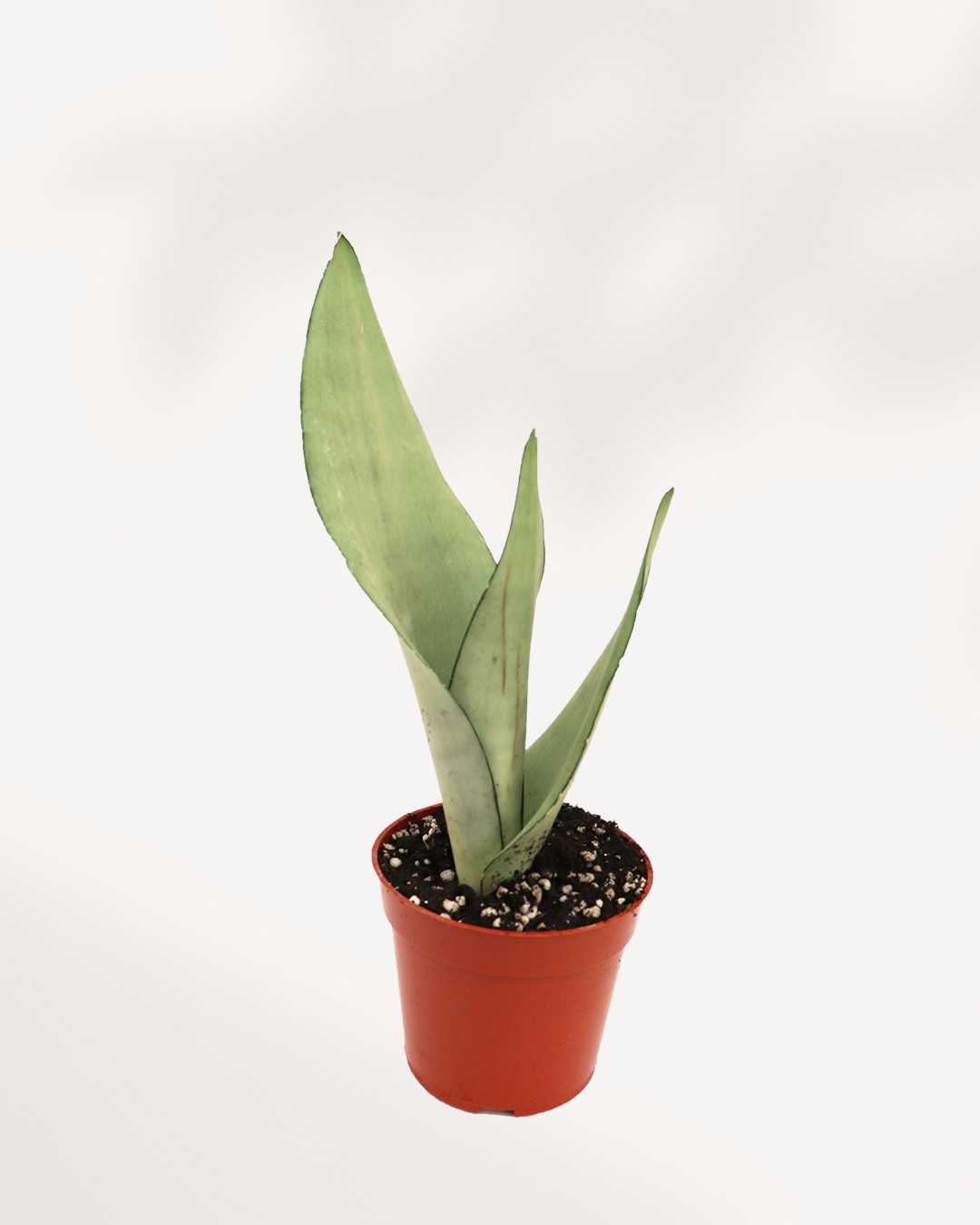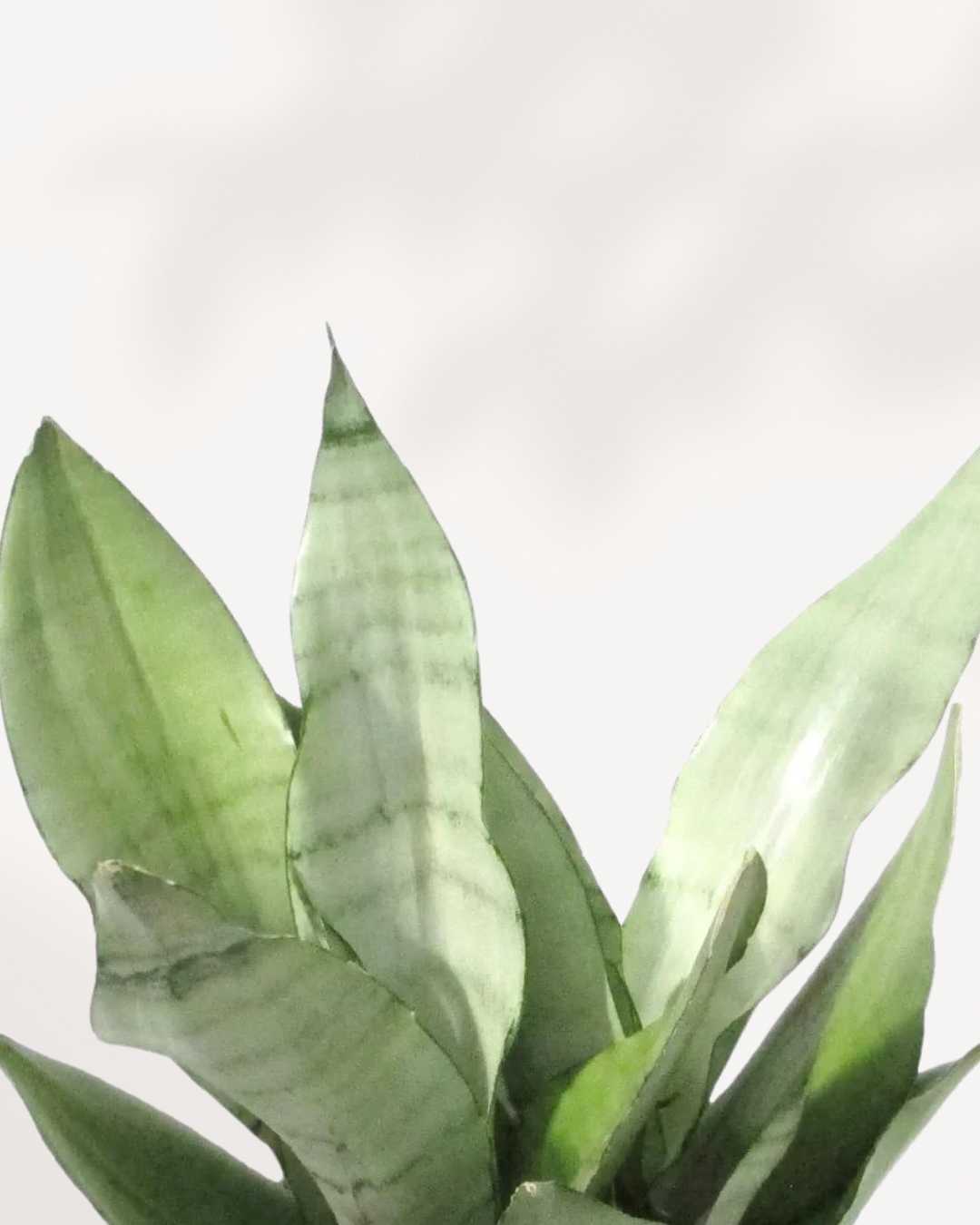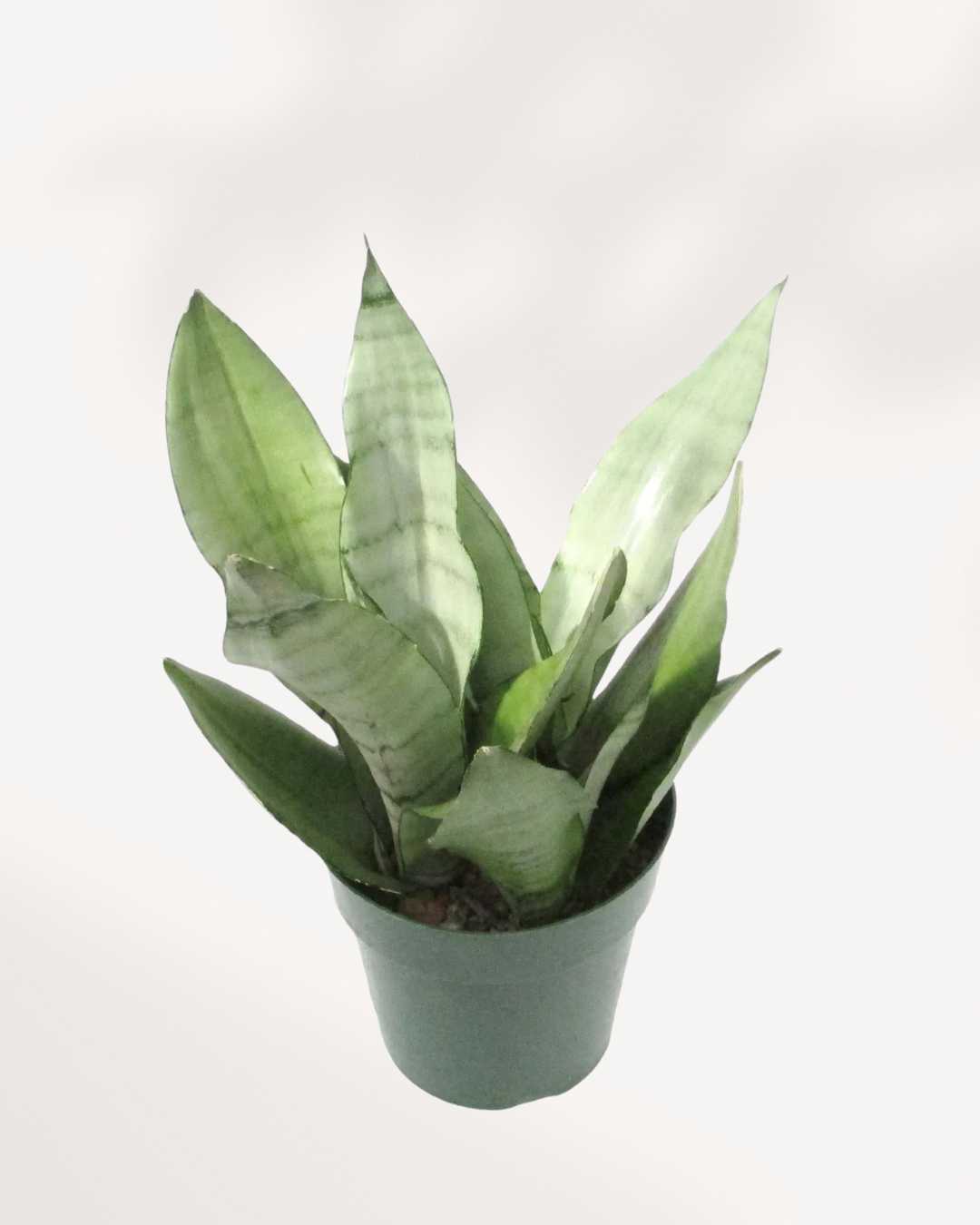Couldn't load pickup availability
Sansevieria Moonshine, also known as Silver Snake Plant, is a stunning variety celebrated for its pale, silvery-green leaves and modern appeal. Its upright growth and elegant coloring make it a standout piece in any indoor garden. Renowned for its low-maintenance care and air-purifying qualities, this versatile plant thrives in various lighting conditions, making it ideal for homes and offices.
Common Names
- Moonshine Snake Plant
- Silver Snake Plant
- Sansevieria Moonlight
Botanical Classification
- Kingdom: Plantae
- Order: Asparagales
- Family: Asparagaceae
- Genus: Dracaena (formerly Sansevieria)
- Species: Dracaena trifasciata
Native Habitat
Sansevieria Moonshine is native to arid regions of West Africa, where it thrives in dry, rocky environments. Its natural habitat has equipped it to withstand drought, making it highly adaptable to indoor conditions with minimal care requirements.
Historical and Cultural Significance
Praised for its elegance and resilience, Sansevieria Moonshine is often associated with protection and positive energy. Its striking appearance and ability to filter toxins have cemented its status as a decorative and functional houseplant across cultures.
Uses and Popularity
Known for its sleek, modern look, Sansevieria Moonshine complements minimalist and contemporary decor. It’s prized as a natural air purifier, removing toxins and improving indoor air quality. Its hardy nature makes it ideal for busy households, offices, and low-light areas.
Conservation Status
Sansevieria Moonshine is widely cultivated and not considered endangered, ensuring its availability in nurseries and plant shops worldwide.
Description
Physical Characteristics
Sansevieria Moonshine features broad, upright leaves with a silvery-green hue and faint horizontal bands. Its leaves grow in a rosette pattern, adding a structured and modern look to any setting.
Growth Habit
This plant has a slow to moderate growth rate, reaching up to 2-3 feet (60-90 cm) in height. It grows upright, making it an excellent choice for narrow spaces or as a statement plant.
Popular Sansevieria Varieties
Sansevieria Laurentii (Snake Plant)
- Features tall leaves with golden-yellow margins and dark green centers.
Sansevieria Boncel (Starfish Sansevieria)
- Compact, star-shaped rosette leaves perfect for small spaces.
Sansevieria Black Coral
- Dark green leaves with silver horizontal streaks for bold contrast.
Sansevieria Cylindrica
- Unique, cylindrical leaves that add texture and vertical interest.
Sansevieria Shark Fin
- Broad, paddle-shaped leaves resembling a shark fin for a dramatic look.
Care Guide
Light Requirements
Sansevieria Moonshine thrives in low to bright, indirect light. It can tolerate low light but grows best with moderate sunlight exposure. Avoid prolonged direct sunlight to prevent leaf burn. Plant Light Requirements
Watering Needs
Water only when the soil is completely dry. Overwatering can lead to root rot. Reduce watering during winter months. Indoor Plant Watering
Soil Preferences
Use a well-draining cactus or succulent potting mix. Adding sand or perlite improves drainage, preventing water retention. Indoor Potting Mix
Humidity
Sansevieria Moonshine adapts well to low humidity, making it perfect for indoor environments with dry air.
Temperature
Maintain temperatures between 60°F to 85°F (16°C to 29°C). Avoid exposure to frost or cold drafts.
Common Pests
Spider Mites
Spider mites can cause leaf damage by sucking sap. Wipe leaves regularly and mist the plant to deter them. Learn More
Mealybugs
White, cotton-like pests that hide in leaf crevices. Remove them with rubbing alcohol or insecticidal soap. Learn More
FAQs
How tall does Sansevieria Moonshine grow?
It can grow up to 2-3 feet indoors with proper care.
Does Sansevieria Moonshine need direct sunlight?
No, it prefers indirect light but can tolerate low light conditions.
How often should I water Sansevieria Moonshine?
Water only when the soil is completely dry, typically every 2-3 weeks.
Is Sansevieria Moonshine pet-friendly?
No, it is toxic to pets if ingested, so keep it out of reach of cats and dogs.
Does Sansevieria Moonshine purify air?
Yes, it removes toxins like formaldehyde and benzene, improving indoor air quality.
How to take care of Sansevieria Moonshine
Sun: Indirect
Sun: Indirect
Light: Low
Light: Low
Water: When Fully dry
Water: When Fully dry
Humidity: Low
Humidity: Low
Pet Friendly: Caution
Pet Friendly: Caution
Pro Tip
Pro Tip
Delivery Policy for Plant Condition
Delivery Policy for Plant Condition
"I have only received part of my order. What to do?
No worries if you've only got part of your order! Our plants come from different nurseries and might arrive in separate shipments, typically 1-2 days apart. It's all part of ensuring your green friends reach you in top-notch condition!
If you do not receive the remaining packages within 48 hours contact support at info@mygreenscape.ca
What is the Life Time Support?
Absolutely! Lifetime support means you can count on us whenever you have questions or uncertainties about your plant. Whether you're puzzled by its behavior or just want to ensure it's thriving, we're here for you. Connect with us on Instagram @mygreenscapeto or shoot us an email at support@mygreenscape.ca.
When it comes to our guarantee for plants shipped with standard or express, rest assured that we offer a 30-day happy healthy plant guarantee on all such shipments. This ensures that your plants are covered for 30 days after delivery, giving you peace of mind regarding their condition. If you have any concerns within this period, feel free to reach out to us for assistance.
For further details, please visit our Local Delivery, Store Pickup, Standard Shipping Guide Page.
What to expect
What to expect
Your plant will arrive in a standard nursery pot, typically 0.5" - 1" smaller than the stated size to seamlessly fit into your chosen decorative pot. Washable Paper Planter Bags are available for separate purchase.
Just like nature intended, each plant is unique, showcasing natural variations in size, shape, and characteristics. Our commitment is to deliver a plant that closely resembles the one featured on our website, matching your chosen size, and with the potential to thrive happily in your home.
Frequently Asked Questions
Frequently Asked Questions
Certainly! If you're pondering about ordering plants online, you're not alone. We've compiled the most frequently asked questions. Check out our FAQ section here for quick answers! Happy planting!
Plant & Pot Size Chart
Plant & Pot Size Chart
Choosing the right pot size for your plants can be a daunting task, especially if you're new to gardening. But fear not! Our pot sizes chart can help you find the perfect match for your plants, ensuring they have enough space to grow and thrive. With our guide, you'll be able to confidently choose the right pot size and plant variety for your gardening needs.
Plant Pot Size Guide.

| Extra Small | 7-10 cm | 2.5 - 3 inches |
| Small | 11-12 cm | 3.5 - 4 inches |
| Medium | 14-17 cm | 5 - 6 inches |
| Large | 19-21 cm | 8 - 10 inches |
| Extra Large | 24-27 cm | 12 - 14 inches |
All sizes are specified in product details.
Your Complete Guide to Pot Sizes: What Size Should You Choose?

When selecting a pot for your plant, it's important to find the right size. But with all the different options out there, how do you know which one is best? We're here to help!
MyGreenscape's pot sizes chart is a great resource for finding your perfect fit. Our easy-to-read chart takes out all the guesswork and helps you quickly choose the right size for your plant.
Smaller pots are best for seedlings or small plants just starting out. These tend to be shallow but wide, allowing enough room for the roots of the young plant but not too much where they get overcrowded. Medium-sized pots are ideal when your plant has grown from its infancy and is ready for more space. These are deeper and wider than small pots, so that it can accommodate larger root systems - making sure your plant gets enough nourishment while still giving it breathing room. Large pots are top choice if you have an established plant in need of lots of space - think trees and large shrubs! The spacious depth and width allow plenty of room for deep root systems without struggling for air or light.
No matter what size you choose, MyGreenscape has got you covered, with our pot sizes chart guaranteeing you find the perfect fit every time!
Winter Shipping Protection
Winter Shipping Protection
We take extra care with each package during the colder months. For destinations experiencing cold weather, we provide insulated packaging and heat packs as needed to protect your plants from freezing temperatures. With Winter Shipping Protection, your plants are equipped to arrive safe and sound, even in winter’s chill.
Care Guide
Care Guide
Explore essential care tips. check out our Comprehensive Resource for Indoor Plant Care.



WATERING MADE EASY
Check soil moisture before watering and use a potting mix that drains well. It’s the secret to healthy, happy plants!
Hear From Happy Plant Parents.
Who have brought Mygreenscape plants into their homes.
















